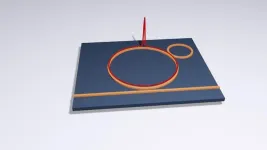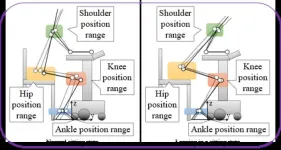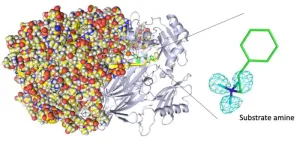(Press-News.org) Microcombs can help us discover planets outside our solar system and track new diseases in our bodies. But current microcombs are inefficient and unable to reach their full potential. Now, researchers at Chalmers University of Technology in Sweden have scored a world first with their solution to make microcombs ten times more efficient. Their breakthrough opens the way to new discoveries in space and healthcare and paves the way for high-performance lasers in a range of other technologies.
Laser frequency combs can measure frequencies with revolutionary precision and are considered the most disruptive technological advance in the field since the birth of the laser. Simply put, a microcomb is like a ruler made of light. The principle is based on a laser sending photons that circulate inside a small cavity, a so-called microresonator, where the light is divided into a wide range of frequencies. These frequencies are precisely positioned in relation to each other, like the markings on a ruler. Thus, a new kind of light source can be created consisting of hundreds – or even thousands – of frequencies, like lasers beaming in unison.
Since virtually all optical measurements are connected to light frequencies, the microcomb has a multitude of applications – from calibrating instruments that measure signals at light-year distances in space in the search for exoplanets, to identifying and keeping track of our health via the air we exhale.
Unprecedented, ground-breaking efficiency
Up to now, a fundamental problem with microcombs has been that their efficiency was too weak to produce a wider technological impact on society. The conversion efficiency between the laser and the microcomb was too weak, meaning that only a fraction of the power contained in the laser beam was usable. But now, a Chalmers research team has successfully developed a method to increase the effect of the microcomb’s laser beams tenfold.
“We’ve developed a new method that breaks what was previously thought to be a fundamental limit for optical conversion efficiency. Our method increases the laser power of the soliton microcomb by ten times and raises its efficiency from around 1 percent to over 50 percent,” says Victor Torres Company, Professor of Photonics at Chalmers.
The new method uses two microresonators, as opposed to just one. They form a unique ensemble with properties that are greater than the sum of its parts. One of the resonators enables the light coming from the laser to couple with the other resonator; rather like impedance matching in electronics.
“The new microcombs have transformative potential because they make high-performance laser technology available to many more markets. For example, frequency combs could be used in lidar modules for autonomous driving, or in GPS satellites and environmental sensing drones, or in data centres to enable bandwidth-intensive AI apps,” says Torres Company.
More about the study:
The method opens up completely new areas of application for high-performance lasers. The technology was recently patented by the project’s researchers. They have founded Iloomina AB, a company which will launch the technology onto a wider market.
The study was conducted by researchers Óskar B. Helgason, Marcello Girardi, Zhichao Ye, Fuchuan Lei, Jochen Schröder and Victor Torres Company at the Department of Photonics at the Department of Microtechnology and Nanoscience at Chalmers University of Technology.
Read the study “Surpassing the nonlinear conversion efficiency of soliton microcombs” published in Nature Photonics
The research project was financed by the European Research Council and the Swedish Research Council.
For more information, please contact:
Victor Torres Company, Professor, Department of Microtechnology and Nanoscience, Chalmers University of Technology, +46 31 772 19 04, torresv@chalmers.se
END
New method makes microcombs ten times more efficient
2023-09-20
ELSE PRESS RELEASES FROM THIS DATE:
Over 50s with ADHD ‘overlooked’ for diagnosis and treatment, say experts
2023-09-20
Doctors urgently need better international guidance on treating attention deficit hyperactivity disorder (ADHD) in the over 50s, conclude world-leading experts reviewing current research on this increasing issue globally.
Published in the peer-reviewed journal Expert Review of Neurotherapeutics, the team’s findings highlight a ‘striking’ gap in knowledge about older people as existing guidelines focus on children and young adults.
“Our analysis concludes that better approaches are urgently required to screen and diagnose people aged from around age 50 to 55,” says lead author Dr Maja Dobrosavljevic ...
New evidence confirms patients with severe psoriasis are at a higher risk for heart disease
2023-09-20
Philadelphia, September 20, 2023 – In the largest study to date exploring the relationship between severe psoriasis and coronary microvascular dysfunction, researchers have found further evidence that patients with severe psoriasis are at higher cardiovascular risk. The results are published in the Journal of Investigative Dermatology, published by Elsevier.
Psoriasis is a chronic systemic immune-mediated inflammatory disease that affects 1-3% of the global population. In this study, a total of 503 patients with psoriasis, and without clinical cardiovascular disease, underwent transthoracic Doppler echocardiography to evaluate coronary microcirculation. ...
Google could play a big role in protecting the health of American children
2023-09-20
Applying Google’s own nutrition advertising policy to the US market would slash the number of products from the country’s top 25 food and beverage manufacturers that could be marketed to children online, according to new research from The George Institute for Global Health.
Published today in the American Journal of Preventive Medicine, the findings suggest the global company could play a significant role in improving the health of future generations by reducing their exposure to, and preference for, unhealthy foods and drinks.
Lead author Dr Elizabeth Dunford, Research ...
Should we screen all newborns for neurodevelopmental disorders?
2023-09-20
Expanding newborn screening (NBS) to include identifying genes associated with an increased risk for neurodevelopmental disorders (NDD) would cause more harm than good, according to an article published in Pediatrics. While some experts believe early identification of NDDs in the newborn period would provide an equitable way to flag and treat disabilities early, the authors of the new paper contend that broader genomic sequencing would worsen existing health disparities.
“The benefit of early genomic screening hinges upon the ability ...
Creation of training data to estimate the states of care robot users
2023-09-20
Overview
A research team led by Assistant Professor Mizuki Takeda from the Department of Mechanical Engineering, Toyohashi University of Technology, has developed a technique to generate training data for robots that operate based on estimations of the user’s state using machine learning. To date, some methods based on machine learning have been proposed to estimate the state of a robot users using candidate points for the position of the center of gravity. However, for such learning, training data corresponding to when the robot is used to support movements are required. The above-mentioned research ...
How good is Google Bard’s visual understanding? An empirical study on open challenges
2023-09-20
Bard, Google’s AI chatbot, based on LaMDA and later PaLM models, was launched with moderate success in March 2023 before expanding globally in May. It’s a generative AI that accepts prompts and performs text-based tasks like providing answers, and summaries, and creating various forms of text content. On 13 July 2023, Google Bard announced a major update which allowed providing images as inputs together with textual prompts. It was claimed that Bard can analyze visual content and provide a description (e.g., image captions) or answer questions using visual ...
Global obesity battle stymied: Deeper understanding is needed
2023-09-20
Prof. John Speakman from the Shenzhen Institute of Advanced Technology (SIAT) of the Chinese Academy of Sciences, alongside Prof. Kevin Hall from the National Institutes of Health (U.S.), Prof. Thorkild Sorensen from the University of Copenhagen and Prof. David Allison from Indiana University (U.S.), has published a perspective article on potential mechanisms of obesity pathogenesis.
It was based on an academic conference held by The Royal Society, with experts and scholars in the field of obesity research discussing the potential pathogenesis of obesity.
This article was published in Science on Aug. 31.
Governments ...
Imaging the smallest atoms provides insights into an enzyme's unusual biochemistry
2023-09-20
Osaka, Japan – When your wounds heal and your liver detoxifies a poison such as histamine you ingested, you can thank the class of enzymes known as copper amine oxidases for their assistance. Identifying the exact positions of the smallest hydrogen atoms in these enzymes is challenging with commonly used technologies, but is critical to engineering improved enzymes that exhibit unusual yet useful biochemical reactivity.
Now, in a study recently published in ACS Catalysis, a team led by researchers ...
Grant supports research on extreme risk of alcohol abuse among Pacific Islander young adults
2023-09-20
RIVERSIDE, Calif. -- In previous research, Andrew Subica and his colleagues found exceptionally high rates of alcohol use disorder (or alcohol abuse) and alcohol-related harms among Pacific Islander young adults. Now Subica, an associate professor in the UC Riverside School of Medicine’s Department of Social Medicine, Population, and Public Health, has received a $3 million grant from the National Institute on Alcohol Abuse and Alcoholism, or NIAAA, of the National Institutes of Health to conduct research aimed at preventing these disorders and harms in Pacific ...
Understanding bacterial motors may lead to more efficient nanomachine motors
2023-09-20
A research group led by Professor Emeritus Michio Homma (he, him) and Professor Seiji Kojima (he, him) of the Graduate School of Science at Nagoya University, in collaboration with Osaka University and Nagahama Institute of Bio-Science and Technology, have made new insights into how locomotion occurs in bacteria. The group identified the FliG molecule in the flagellar layer, the ‘motor’ of bacteria, and revealed its role in the organism. These findings suggest ways in which future engineers could build nanomachines with full control over their movements. They published the study in iScience.
As nanomachines become ...






